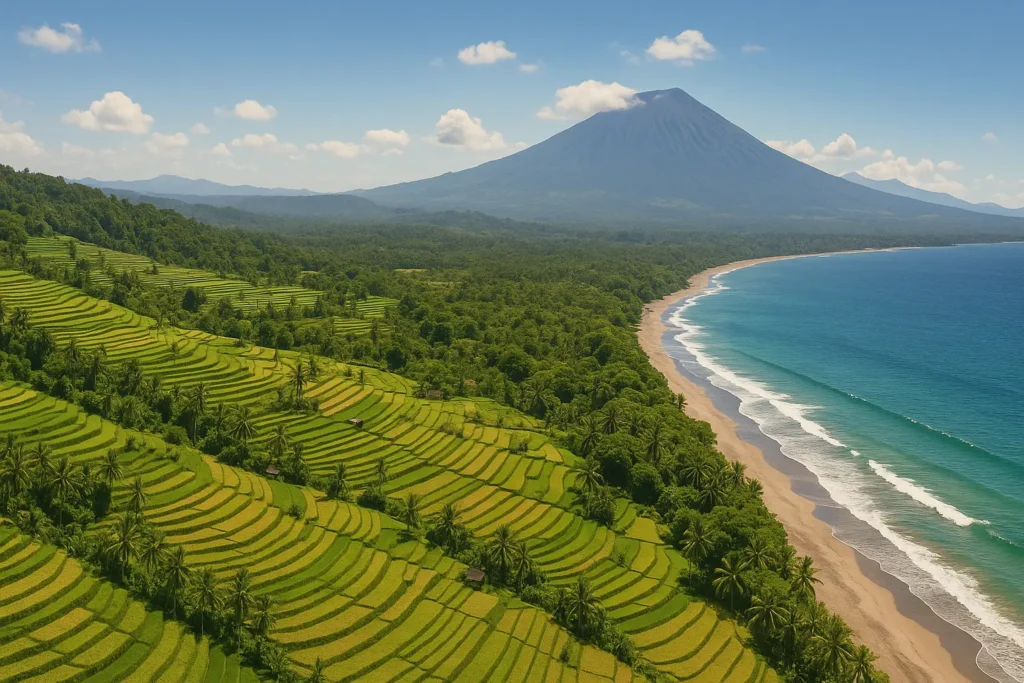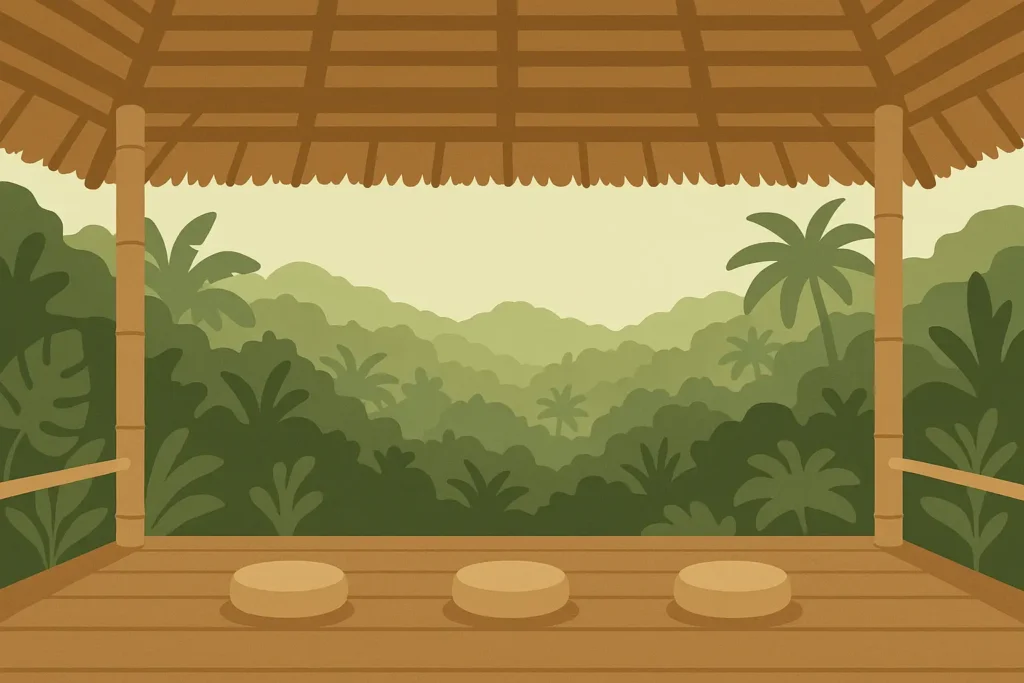A travel blogger I follow mentioned that most first-time visitors to Bali spend just one week exploring the island, but honestly? That barely scratches the surface of what this place offers. I learned this the hard way during my first trip when I tried to hit Ubud, Seminyak, AND the Gili Islands in 5 days. By day 3, I was exhausted, stressed about constant packing and unpacking, and honestly pretty cranky. I spent more time stuck in traffic than actually enjoying anything.
Avoid travel burnout before it starts — plan your perfect Bali itinerary with our Vacation Planner.
That rushed experience taught me that thoughtful planning isn’t just nice to have – it’s essential if you want to actually enjoy your Bali trip instead of just surviving it. Whether you’re dreaming of sunrise volcano hikes (spoiler: pack layers), spiritual wellness retreats, or romantic beachfront dinners, the right approach makes all the difference between a good trip and one that changes you.
Quick Resources:
-
Design your dream island escape with our Vacation Planner
-
Keep your travel budget stress-free with the free Bachelorette Budget Calculator
-
Plan the perfect group celebration or girls’ trip with our Bachelorette Party Planner
-
Start planning your post-wedding adventure using our Honeymoon Planner
-
Explore all our Wedding Tools to simplify destination weddings and romantic getaways
Real Talk Summary
- Stay at least 7 days if you want to actually relax – 14 days is the sweet spot for seeing everything without feeling rushed
- Budget anywhere from $25-40/day (if you’re okay with hostels and street food) to $200+/day (if you want luxury everything), with $75-125/day hitting that comfortable middle ground
- Dry season (April-October) = better weather but way more crowds and higher prices
- Staying in one place lets you actually get to know it; hopping around gives you variety but more packing stress
- Bali traffic is no joke – factor it into every single day
- Different trip styles (wellness, adventure, cultural deep-dives, foodie tours) need totally different approaches
- Solo, friends, family trips all have their own challenges and perks
- Honeymoons and anniversaries are worth splurging on
Keep your Bali budget on track with our free Bachelorette Budget Calculator — perfect for managing day-to-day travel costs with ease.
How Long Should You Actually Stay?
Here’s the thing about time in Bali – it’s your most valuable resource, and how long you stay completely changes what you can experience. I’ve done everything from frantic 3-day trips to month-long stays, and trust me, there’s a huge difference.
Use our Vacation Planner to map out your ideal Bali trip length and choose destinations that fit your travel style.
| How Long | Where to Focus | What You’ll Actually Do | Best For |
|---|---|---|---|
| 3-4 Days | Seminyak + Ubud | Hit the highlights, take lots of photos | Weekend warriors with limited time |
| 7 Days | South + Central Bali | Actually enjoy things without rushing | Most people (this is the sweet spot) |
| 10 Days | Multiple regions | Deep dive into 2-3 areas | People with generous vacation time |
| 14 Days | Whole island + day trips | See everything without burning out | Thorough explorers |
| 30 Days | Slow travel everywhere | Live like a temporary local | Digital nomads, gap year travelers |
1. Weekend Getaway (3-4 Days)
Look, I’m not going to sugarcoat this – four days in Bali feels frantic. You’ll hit Seminyak’s beach scene, see Ubud’s rice terraces, and maybe catch a sunset at Tanah Lot temple, but you’ll spend more time in transit than you’d like. It’s like speed dating with an entire island.
That said, if it’s all the time you’ve got, focus on two areas max and accept that you’re getting a taste, not the full experience. At least you’ll know if Bali’s worth a longer return trip (spoiler: it is).
2. The Sweet Spot Week (7 Days)
Seven days is where Bali starts to make sense. You can split time between the beaches and nightlife down south and the culture and nature in central Bali without feeling like you’re constantly packing and unpacking. More importantly, you have breathing room for those spontaneous moments that make travel memorable.
You can handle a delayed flight, spend an extra hour at that perfect sunset spot, or take an impromptu cooking class without your entire schedule falling apart. It’s comprehensive enough to satisfy most travel goals while leaving room for the unexpected stuff that often becomes your favorite memories.
Build in room for spontaneity while staying organized — try our Vacation Planner for flexible, stress-free travel planning.
3. Extended Explorer (10 Days)
Ten days transforms your trip from a vacation into an experience. You’ll start recognizing faces at your local warung, develop preferences for specific beaches, and actually have time to read that book you brought. The pace becomes sustainable rather than exhausting.
This timeframe lets you do deeper regional exploration, enjoy multiple sunrise experiences (if you’re into that early morning thing), and maybe even take day trips to neighboring islands. You can balance active adventures with chill-out periods, which is crucial for avoiding travel burnout.
4. Two-Week Deep Dive (14 Days)
This is the gold standard for Bali exploration. You can hit the main island thoroughly AND venture out to places like the Nusa Islands or North Bali’s mountains and lakes. You’ll have time for both planned activities and spontaneous discoveries, plus adequate rest periods.
I’ve watched people try to cram two weeks’ worth of activities into one week – trust me, it doesn’t work. You end up exhausted and cranky instead of relaxed and inspired.
5. Month-Long Immersion (30 Days)
A month in Bali changes you. You’ll find yourself greeting shopkeepers by name, understanding the rhythm of daily life, and maybe even picking up some Bahasa Indonesia. This duration is perfect for digital nomads, gap year travelers, or anyone seeking a genuinely transformative experience.
You can establish routines, build real relationships with locals, and experience Bali beyond the tourist trail. It’s the difference between visiting a place and actually living there, even temporarily.
What Kind of Trip Are You After?
Your interests should drive your travel plans way more than generic “must-see” lists. I’ve seen too many people force themselves through experiences they don’t actually enjoy just because Instagram says they should. Here’s how to plan a trip that actually fits what gets you excited.
6. Wellness & Getting Your Life Together
If you’re coming to Bali to reset your mind, body, and maybe your entire life perspective, Ubud and Canggu are your home bases. Daily yoga sessions, meditation retreats, traditional Balinese healing, and food that doesn’t make you feel terrible afterward – this is where the magic happens.
Ready to plan a wellness retreat or girls’ trip in Bali? Use our Bachelorette Party Planner to coordinate group itineraries, yoga sessions, and self-care experiences.
Here’s what a real wellness day looks like: 6 AM sunrise yoga in a jungle setting (yes, you’ll actually want to wake up early), followed by a breakfast bowl that makes you feel like a health goddess. Mid-morning might include a session with a traditional healer – and I’m talking about people who’ve been practicing these techniques for generations, not some Instagram wellness guru.
Lunch at an organic farm-to-table restaurant, afternoon meditation in actual rice fields (not just looking at them), evening cooking class focused on healthy Balinese cuisine, and maybe end with a sound healing session as the sun sets. It sounds intense, but it’s the kind of intense that leaves you feeling centered rather than drained.
Fair warning: wellness travel in Bali goes way beyond Instagram-worthy yoga poses. You’ll discover healing traditions that have been practiced for centuries and experience the kind of deep relaxation that’s impossible to achieve in your regular routine.
7. Adventure & Adrenaline Junkie
If sitting still makes you antsy, Bali’s got your number. Volcano hiking, white water rafting, diving expeditions, surfing lessons – you can push your comfort zone daily while experiencing the island’s natural beauty from perspectives most tourists never see.
Pro tip from someone who learned the hard way: that 3:30 AM Mount Batur hike? Pack layers. I froze my butt off in shorts and a tank top while watching the sunrise with chattering teeth. Also, moderate to high fitness levels help, but the guides are pros at keeping everyone safe.
8. Cultural Deep Dive
This is for people who want to understand Bali, not just photograph it. You’ll focus on temples, traditional villages, religious ceremonies, and art workshops. Based primarily in Ubud, Sidemen, and Munduk, this approach emphasizes authentic cultural exchanges over tourist attractions.
Cultural immersion requires patience and openness to experiences outside your comfort zone. You might find yourself participating in temple ceremonies at 5 AM or learning traditional crafts from artisans who’ve perfected their skills over decades. It’s not always comfortable, but it’s always enlightening.
9. Photography & Instagram Goals
Let’s be honest – some of you are here for the shots, and that’s totally fine. Just know that getting those perfect photos requires strategic planning around golden hour lighting and iconic locations, plus early morning starts to beat the crowds.
Fair warning about that Instagram-famous Lempuyang Temple gate – you’ll wait 2+ hours for the photo, and spoiler alert: there’s actually a guy holding up a mirror under an iPhone to create that ‘reflection’ effect. Still cool, but manage your expectations.
Weather dependency is high for this kind of trip, making dry season travel pretty much essential for consistent results. You’ll wake up before dawn regularly, but the shots you’ll capture make those early mornings worthwhile.
10. Foodie Adventure
Bali’s food scene goes way beyond nasi goreng and satay, though both are delicious. This approach focuses on cooking classes, market tours, restaurant hopping, and coffee plantation visits across the entire island.
The cooking classes provide hands-on learning, while market visits offer cultural insights into local ingredients and food traditions. You’ll develop an appreciation for Balinese cuisine that goes far beyond basic tourist dishes and maybe pick up some skills to impress people back home.
What You’ll Actually Spend
Let me give you the real talk about Bali costs, because budget significantly influences everything from where you sleep to what you eat to how you get around.
| Budget Level | Daily Reality | Where You’ll Sleep | How You’ll Get Around | What You’ll Eat | What You Can Do |
|---|---|---|---|---|---|
| Backpacker | $25-40 | Hostels, basic guesthouses | Scooter, local transport | Street food, warungs | Free temples, hiking, beaches |
| Comfortable | $75-125 | Nice hotels, boutique places | Private driver for day trips | Mix of local and tourist spots | Most activities and tours |
| Luxury | $200+ | 5-star resorts, private villas | Private transfers everywhere | Fine dining experiences | Exclusive everything |
| Family | $100-150 (family of 4) | Family rooms, connecting rooms | Private family-friendly transport | Kid-friendly restaurants | Age-appropriate activities |
| Couples | $150-250 | Romantic villas, couple resorts | Private romantic transfers | Candlelit dinners | Romantic experiences |
11. Backpacker Budget ($25-40/day)
Look, $25/day is totally doable if you’re okay with basic hostels and eating at local warungs (which honestly serve better food than most tourist restaurants anyway). You’ll share dorm rooms with fellow travelers, navigate local transport systems, and discover hole-in-the-wall eateries that serve incredible food for pocket change.
The trade-off? You need flexibility and comfort with basic amenities. But you’ll get the most authentic cultural immersion and meet the most interesting people. Free activities like temple visits, hiking, and beach time become your foundation.
12. The Sweet Spot ($75-125/day)
This is where most people should aim. You get three-star hotels or boutique properties, can mix dining between local spots and tourist restaurants, and afford private drivers for day trips. It’s the balance between comfort and value that lets you access most experiences without breaking the bank.
Mid-range travel offers the best of both worlds. You can splurge on that sunset dinner at a cliff-top restaurant one night and grab street food the next. Your accommodation will be comfortable enough for good sleep but won’t consume your entire budget.
13. Living the Luxury Life ($200+/day)
Premium accommodations, fine dining, private transfers, and exclusive access to high-end activities. This budget eliminates most logistical concerns and provides maximum comfort, but requires significant financial investment.
The focus shifts from budget management to experience optimization. You’ll have dedicated concierge services, private pools, and access to experiences that aren’t available to general tourists.
14. Family Reality Check ($100-150/day for family of 4)
Family travel requires balancing everyone’s needs with reasonable costs. Family-friendly accommodations, restaurants with high chairs and changing facilities, private family transport, and activities that keep everyone engaged without overwhelming younger travelers.
Safety and convenience take priority over luxury. You might compromise on some premium adult-focused experiences, but you’ll create memories that work for the whole family.
15. Romantic Splurge ($150-250/day)
Private villas, couples-focused resorts, candlelit dinners, couple’s spa treatments, and private romantic experiences. This budget prioritizes intimacy and special moments, making it ideal for honeymoons, anniversaries, and romantic getaways.
Planning your dream honeymoon or anniversary trip? Start crafting your romantic getaway with our Honeymoon Planner.
When to Go (And When to Avoid the Crowds)
Bali’s weather patterns create distinct advantages and challenges depending on when you visit. Understanding these seasonal differences helps you optimize your trip for your priorities – whether that’s perfect weather, fewer crowds, or better prices.
16. Dry Season Reality (April-October)
Perfect weather for outdoor activities, temple visits, and photography, but you’ll pay for it with peak pricing and crowds everywhere. During July, expect daily temperatures around 80°F with zero rainfall – perfect for that Mount Batur sunrise hike starting at 3:30 AM.
However, accommodation prices jump 40-60%, and popular spots like Lempuyang Temple require 2-hour waits for photos. Advanced booking is essential because everyone else had the same brilliant idea to visit during perfect weather.
17. Wet Season Truth (November-March)
Here’s what nobody tells you about rainy season: it’s not that bad. Yeah, you’ll get afternoon thunderstorms lasting 1-2 hours, but hotel rates drop significantly, crowds thin out, and the landscape becomes incredibly lush and photogenic.
I actually prefer wet season travel for the dramatic skies and vibrant green scenery. The rain typically comes in short, intense bursts rather than all-day downpours, leaving plenty of time for exploration. Plus, everything turns this incredible shade of green that you just don’t get in dry season.
18. Shoulder Season Smart (March-April, October-November)
The best of both worlds – balanced weather with moderate pricing. You might get some weather unpredictability, but you’ll enjoy good value and manageable crowd levels. This timing works perfectly if you’re flexible and can adapt to changing conditions.
19. Festival Season (Nyepi, Galungan, Kuningan)
Want to experience authentic Balinese culture? Time your visit around major religious celebrations. These periods offer incredible cultural experiences and traditional ceremonies, but require advance planning and cultural sensitivity.
Experiencing Nyepi is unforgettable – the entire island goes silent for 24 hours. No flights, no traffic, no lights. It’s surreal and beautiful, but you need to stock up on food and entertainment beforehand because literally everything closes.
Travel smarter and make the most of every season with our Vacation Planner — perfect for mapping out experiences around Bali’s cultural festivals.
20. Surf Season Specialist (May-September)
Consistent waves and dry conditions create ideal surfing conditions, especially around Canggu and Uluwatu. This season attracts serious surfers worldwide, leading to crowded surf breaks but excellent wave quality. If you’re here for the waves, this is your time.
Who Are You Traveling With?
Different group dynamics completely change how you should approach Bali. Solo travelers need different considerations than families, and what works for friends might be terrible for couples.
21. Solo Adventure
Solo travel in Bali feels incredibly safe, especially for women. The local culture is welcoming, and there’s a strong community of solo travelers who look out for each other. Focus on social hubs like Canggu and Ubud where group tours, yoga classes, and co-working spaces provide natural meeting opportunities.
Higher per-person costs are offset by complete schedule control – you can wake up when you want, eat where you want, and change plans on a whim without consulting anyone.
22. Friends Trip
Group dynamics can make or break a trip. Establish ground rules early about budgets, wake-up times, and must-see experiences to avoid conflicts later. Villa accommodations and group tours provide cost savings and bonding opportunities.
Focus on shared experiences, nightlife, and group activities with bases in Seminyak and the Gili Islands. The challenge is coordinating different interest levels and energy levels throughout the trip.
23. Multi-Generational Family
Accessible activities for all ages work best, focusing on family-friendly areas like Sanur and Nusa Dua. Cultural sites, easy hikes, and beach time accommodate different mobility levels and interests. Higher overall costs are balanced by educational value and family bonding opportunities.
Special Occasions That Need Extra Planning
Milestone moments deserve special treatment. These trips focus on creating unforgettable memories rather than checking boxes or staying within tight budgets.
24. Honeymoon Bliss
Romance-focused planning emphasizing privacy, luxury, and intimate experiences across Seminyak, Ubud, and Nusa Dua. Couple’s spa treatments, private dinners, and romantic excursions create the perfect post-wedding celebration.
Honeymoon planning requires balancing adventure with intimacy. You want Instagram-worthy moments but also private time to actually connect as newlyweds. The 10-14 day duration allows for both adventure and relaxation while maintaining romance throughout.
25. Milestone Celebration (Anniversary, Birthday)
Special dining experiences, exclusive activities, and personalized services create lasting memories for significant life moments. The 7-10 day duration focuses on quality over quantity, emphasizing exceptional experiences rather than comprehensive coverage.
Real Day-by-Day Breakdowns
Here’s what these itineraries actually look like when you’re living them, including the stuff that goes wrong and the spontaneous magic that happens.
Classic Week in Bali (7 Days) – What Actually Happens
This balanced approach splits time between South Bali’s beaches and Central Bali’s culture. Each day includes realistic timing, transportation details, and honest cost breakdowns.
Day 3 Sample Schedule – Ubud Cultural Day (Planned vs. Reality):
Planned: 6:00 AM pickup for Tegallalang Rice Terraces
Reality: Actually rolled out of bed at 8 AM because jet lag is real
Planned: Quick coffee tasting at plantation
Reality: Coffee tasting turned into a 2-hour chat with the farmer about his family (best part of the day)
Planned: Visit Tegenungan Waterfall for photos
Reality: Spent 3 hours there because it was so gorgeous we couldn’t leave
The lesson? Build buffer time for spontaneous magic. Total day cost ended up around $35-40 per person including transport, but the unplanned conversations were priceless.
Two-Week Deep Dive (14 Days) – Extended Reality
Two weeks transforms your relationship with Bali from tourist to temporary resident. Week one establishes your foundation with main Bali regions, while week two explores extended areas like Nusa Penida and North Bali.
You’ll develop routines, favorite spots, and genuine connections with locals. By week two, you’re not just visiting places – you’re returning to places you’ve started to love.
Wellness & Retreat Focus (10 Days) – Transformative Reality
This progression starts with accessible wellness activities in Canggu, moves to intensive retreat experiences in Ubud, and concludes with spiritual immersion in traditional Sidemen. The progression allows gradual adaptation to wellness practices while providing genuinely transformative experiences.
What Actually Matters When Planning
Understanding how different approaches perform against real-world considerations helps you make informed decisions rather than getting caught up in theoretical perfection.
| Trip Type | Best Duration | Physical Demands | Weather Dependency | Cultural Immersion | Logistics Complexity |
|---|---|---|---|---|---|
| Weekend Warrior | 3-4 days | Easy-Medium | Some | Surface level | Simple |
| Classic Week | 7 days | Medium | Some | Good balance | Manageable |
| Adventure Focus | 10-14 days | High | Very dependent | Limited | Complex |
| Wellness Retreat | 7-10 days | Low | Not much | Deep personal | Simple |
| Cultural Deep-Dive | 10-14 days | Low-Medium | Not much | Very high | Medium-Complex |
| Photography Focus | 7-14 days | Medium | Extremely dependent | Limited | Complex |
| Family Trip | 7-10 days | Easy-Medium | Some | Family-appropriate | Manageable |
| Luxury Experience | 7-14 days | Whatever you want | Not much | Curated | Simple (others handle it) |
Let Me Tell You About Bali Traffic…
Transportation reality check: Traveling from Seminyak to Ubud (35km) takes 1.5-2 hours by scooter during peak traffic, costing about $4 in fuel. The same journey by private driver costs $25-35 but includes air conditioning, local insights, and photo stops. Public transport costs under $2 but requires multiple transfers and 3-4 hours total travel time.
Factor these time and comfort trade-offs into every single day. That “quick” temple visit becomes a half-day commitment when you include travel time.
Duration & Timing Reality
Longer stays provide exponentially better experiences. Seven days is the minimum for meaningful exploration, fourteen days offers comprehensive coverage without burnout. Weekend trips work for limited vacation time but miss deeper cultural connections.
Budget Impact Truth
Budget levels dramatically influence experience quality. Backpacker budgets provide authentic local experiences but limited comfort. Luxury budgets eliminate logistical headaches but require significant investment. Mid-range budgets offer the best balance for most travelers.
How Bridesmaid for Hire Can Help Your Bali Celebration
Planning a destination wedding or honeymoon in Bali involves complex logistics and cultural considerations that can overwhelm even experienced travelers. Whether you’re planning a destination wedding in Ubud’s rice terraces, a romantic honeymoon in Seminyak, or a celebration trip with your wedding party, professional support makes a huge difference.
Bridesmaid for Hire brings the same level of care and attention to detail to your Bali adventure that we provide for weddings. Our services include pre-trip planning consultation to create the perfect romantic itinerary, coordination with local vendors and cultural requirements, and on-ground assistance during your Bali celebration.
Ready to make your Bali dreams a reality? Contact Bridesmaid for Hire to discuss how our professional support can transform your destination wedding or honeymoon planning experience, because everyone deserves support from someone who’s actually paid to care this much about your special moments.
Explore all of our wedding and travel planning tools at the Wedding Tools Hub — your one-stop destination for stress-free celebration planning.
Final Thoughts
Look, Bali isn’t perfect. The traffic will test your patience, you might get Bali belly, and that “hidden” waterfall probably has 50 other tourists there. But there’s something about this place that gets under your skin. Maybe it’s the way locals smile at you, or how a random conversation with a rice farmer becomes the highlight of your trip.
The 25 itineraries here represent tested approaches that account for Bali’s unique challenges – from notorious traffic to seasonal weather patterns to cultural considerations. But remember that flexibility remains your greatest asset when traveling in Indonesia.
Most importantly, don’t try to see everything in one trip. Bali rewards return visitors who take time to develop deeper connections with places and people. Pick what genuinely excites you, leave room for the unexpected stuff, and start planning your return before you even leave the island.
That’s the Bali effect – once it captures your heart, you’ll find yourself planning your next visit before your first trip ends. Just don’t try to do everything – pick what genuinely excites you and leave room for the unexpected stuff. That’s where the real magic happens.
1-800-BRIDESMAID
The Newlywed
Card Game
something extra to love
Read the weekly newsletter from Bridesmaid for Hire, 1-800-Bridesmaid, to hear about real stories, from strangers, who need advice on love, life, friendship, and so much more.
Looking for the perfect wedding gift for someone you adore? Grab The Newlywed Card Game. It's a fun and interactive game they can play on their honeymoon or future date nights.














